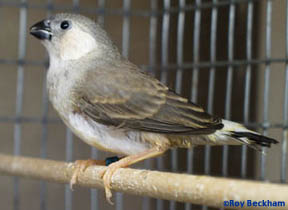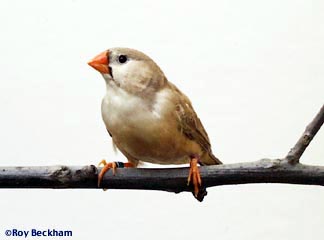Page 1 of 2
Color mutations - genetics
Posted: Mon Apr 30, 2007 10:11 am
by 2-shoes
I'm new to the forum and have had a pair of zebras since Dec 05. The pair were a gift and from a chain pet store. No idea of the parentage or relationship to each other. They are a great pair, fun to watch and listen to.
Recently had a sucessful breeding and I have four fledglings. My surprise is - 3 out of four are color mutations. From some net research, two are pieds. One has quite a bit of white and is striking around the face - with the adolescent black beak. The color of the non-pied mutant has me baffled. It is a bit lighter gray the the traditional colored one - it has no black teardrop markings.
Is there something else that is linked or follows the pied color mutation that accounts for my other little mutant

?
Do most breeders consider pieds as undesirable?
Thanx.
Posted: Mon Apr 30, 2007 9:02 pm
by Crystal
If you can post a picture of the light grey chick, that would be the easiest way to tell you what its likely mutation is (it does not sound like it is due to a pied gene). Also, you may need to wait until the chick finishes its molt into adult colors.
Some breeders prefer pied birds (especially well-marked birds, or if the mutation is still considered rare as it is in other species) while others do not; it is a matter of personal preference.
Posted: Tue May 01, 2007 7:24 am
by kenny
hi 2 shoes
the other one sounds like a penguin mutation to me ,they sometimes occur when there is a strong pied genetic strain try this page out and see if it looks like any one on here
ken
http://www.efinch.com/species/pengzeb.htm
Posted: Tue May 08, 2007 9:38 am
by 2-shoes
Here are my mutants:
The pieds:
http://i200.photobucket.com/albums/aa66 ... ited-1.jpg
and the no black tear drop:
http://i200.photobucket.com/albums/aa66 ... ited-1.jpg
All hens I think (even my normal). No one trying more than regular chatter.
Posted: Tue May 08, 2007 10:51 am
by jave*finch*
black breasted fawn hen

not that sure but i think it is black breasted fawn hen! or an orange breasted hen. but having pied siblings...i have no idea!
Posted: Tue May 08, 2007 5:29 pm
by Crystal
Do you have a picture of the parents?
Posted: Tue May 08, 2007 5:38 pm
by Crystal
She looks like a recessive silver to me. Sometimes their tear drops are so washed out you can hardly see them.
Posted: Tue May 08, 2007 10:41 pm
by 2-shoes
Well, here's the rest of the family.
A couple of pics of mom & dad:
http://i200.photobucket.com/albums/aa66 ... 82eidt.jpg
http://i200.photobucket.com/albums/aa66 ... 87edit.jpg
And my one normal (she is, isn't she?) is the first in the line-up:
http://i200.photobucket.com/albums/aa66 ... C_0919.jpg
I would be very grateful for any info on my little mutant family. I've been reading some of the other genetics posts - are these sex linked color mutations?
Is the silver, no tear drop hen, coloration due to the pied gene or something else?
Thanx.
Posted: Tue May 08, 2007 10:45 pm
by Crystal
Recessive Silver is a separate mutation from pied. They are both autosomal recessive though (not sex-linked).
Posted: Tue May 08, 2007 11:18 pm
by 2-shoes
So, if the no-tear drop hen is a recessive silver - the parents were both carrying two different recessive traits (pied and recessive silver) that happened to come out in one clutch? Wow!
So - I just wanted to verify that the parents look like normal greys and the other chick appears to have normal hen coloration.
Also, since this is my first set of babies - I should expect them to molt sometime between 8 and 12 weeks and then they will have their adult plummage?
Posted: Wed May 09, 2007 12:22 am
by Crystal
If the chick is silver, the parents would have to be carrying 2 recessive traits, correct.
The grey chick does have coloration similar to a grey hen, but it is not necessarily a hen (it could still molt and turn out to be a boy). The parents do look like normal greys.
You are correct about the molting.
Posted: Wed May 09, 2007 3:25 am
by jave*finch*
no it cant be silver! unless the parent bird is visual silver..there is no such thing as split to silver! it must be BB!
Posted: Wed May 09, 2007 10:19 am
by 2-shoes
Sorry - and BB stands for what?
Is there a site that has all the color abbreviations?
Posted: Wed May 09, 2007 11:47 am
by Crystal
Jave, in the US we have recessive silver mutations in addition to Dominant silver. So it can be [recessive] silver and the parents can be non-visual split-for-silver; recessive silver is a separate mutation from dominant silver. Black Breasted (BB) would be a pretty rare find from birds which were not purchased specifically because they were carrying the mutation. You are hard pressed to find mutations like black breasted in pet stores etc. here. Also, the black breasted gene does take away the tear drop in hens, but it does not change the body color to make it paler. Additionally, black breasted fledgelings look more like penguin zebras because of they have pale cheek patches:

2-shoes's baby does not look like this.
2-shoes's baby also does not look like the right shade to be a fawn or fawn-based mutation. The baby is more light grey than brown.
Posted: Wed May 09, 2007 12:16 pm
by jave*finch*
Crystal wrote:Jave, in the US we have recessive silver mutations in addition to Dominant silver. So it can be [recessive] silver and the parents can be non-visual split-for-silver; recessive silver is a separate mutation from dominant silver. Black Breasted (BB) would be a pretty rare find from birds which were not purchased specifically because they were carrying the mutation. You are hard pressed to find mutations like black breasted in pet stores etc. here. Also, the black breasted gene does take away the tear drop in hens, but it does not change the body color to make it paler. Additionally, black breasted fledgelings look more like penguin zebras because of they have pale cheek patches:

2-shoes's baby does not look like this.
2-shoes's baby also does not look like the right shade to be a fawn or fawn-based mutation. The baby is more light grey than brown.
Oh yeah forgot about the recessive silver..sorry!! peace out crystal! there are recessive silvers here too but rare! yeah then you must be right! but if that is recessive it should have a tear mark! read the descriptions
Male: The Recessive Silver mutation causes all of the base gray color to dilute to a lighter, silvery color. The black markings are diluted an equal amount, but remain distinct from the base color. Overall, the mutation works to reduce the grays and blacks (eumelanin) by a "notch" or two. The orange colors of the cheek patch and flanks (phaeomelanin) remain at full strength.
Female: As in the male, the base gray color is diluted and so are the black markings of the tail and tear mark. These are diluted to the same degree as the male.
Fledgling: Recessive Silver chicks can be identified as soon as they feather out in the nest. They will have diluted feathers and look much like the hens.
BTW the bird in your picture is a BBBF and its not fawn!
here's a pic of a fawn BB

compared to 2-shoes bird

BTW Crystal LOVE your site!! learned so much from you so maybe you are right or i am right..but whoever is right it doesn't really matter..does it?
 ?
?

